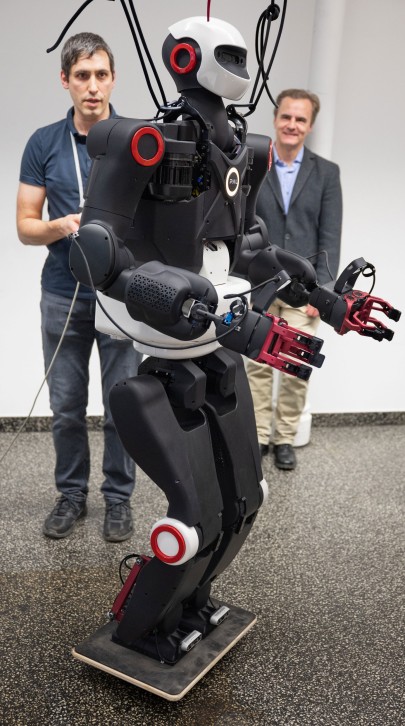“A unique opportunity for Darmstadt as a center for AI and robotics research”
Prof. Jan Peters and Dr. Oleg Arenz discuss the humanoid robot HAINER and the state of AI research at TU Darmstadt
2025/05/21

What is the importance of HAINER for TU Darmstadt, a leading institution in robotics research, given that it is one of only five TALOS robots worldwide and the sole one in Germany?
Jan Peters: 'HAINER is a unique opportunity for Darmstadt as a centre for AI and robotics research! It is of great strategic importance, since only a torque-controlled HAINER with a built-in AI computer can operate 'embodied intelligence', i.e. AI-based robotics, properly. Since TU Darmstadt excels in all areas of AI, from computer vision and natural language processing to robot learning, it is crucial that these fields of research are integrated into a human-like system.
We are very fortunate here because TU Darmstadt took several steps in the right direction at just the right time. Even before the AI boom, outstanding professors were hired to cover all aspects of AI. TU Darmstadt is the only German university to cover AI in its entirety and machine learning in depth. According to Jensen Huang, founder of NVIDIA, the age of humanoid robotics will begin in 2025, as all the necessary basic AI technologies will be in place for the first time. Thanks to TU Darmstadt's timely submission of the large-scale equipment application and the completion of HAINER in February 2025, we are in an excellent position in Darmstadt to lay the foundations for AI-based humanoid robots!
The arrival of HAINER also marked the launch of the new laboratory for humanoid robotics. What research priorities would you like to set for the laboratory in the future?


Oleg Arenz: At the Humanoid Robotics Laboratory, our research focuses on developing fundamental approaches that will enable humanoid robots to assist us in our daily lives in the future. The challenges lie in the diversity of tasks and the complexity of the environment. The robot must continuously learn to adapt to this dynamic environment without losing existing skills. In order to strike a balance between adaptability and stability, we need to transition from monolithic black box systems to modular systems where individual components can be effortlessly replaced or modified.
I see HAINER as an AI nexus – a central connection point where different AI systems converge. These systems operate at different levels of abstraction: large language models such as ChatGPT provide intuition, neurosymbolic approaches find abstract plans, learning by imitation optimises movements, and advanced control methods translate these into motor commands in milliseconds.
All these components require different models that need to be harmonised with each other and require an understanding of the scene that is created and adapted using sensor data. Our research therefore focuses on the overall system, which makes working with robots incredibly exciting and varied and offers numerous opportunities for interdisciplinary collaboration.
Among other things, HAINER can lift weights, climb stairs and walk on uneven surfaces. Which of its features are particularly interesting for your research and why?


Arenz: HAINER's outstanding features are its torque control, its high payload of six kilograms on an extended arm, and its variety of sensors. Torque control allows us to precisely control the forces the robot exerts on its environment. This is not only important for safe interactions with humans, but also helps the robot control its centre of gravity and maintain balance. The high payload allows us to consider practical applications – carrying a crate of water is quite different from carrying an empty cardboard box. The many cameras in the arms, feet and head enable us to create and maintain as complete a 3D model of the environment as possible, which is particularly useful for more complex and time-consuming tasks.
What are the advantages of HAINER over other humanoids?
Arenz: The alternatives currently on the market are primarily intended for locomotion. They are lightweight and can perform impressive movements, such as dancing and somersaults. While these robots certainly put on a good show, they run the risk of becoming boring for research purposes. While the learning methods could certainly be improved, when I observe the acrobatic movements of these humanoid robots, I wonder how long it will be before we exhaust all research questions.
HAINER weighs almost 100 kilograms and won't be able to perform somersaults or flips, but it can get things done. This opens up completely new possibilities for us. A robot that is designed not only to passively wander through the world, but also to actively and purposefully change it, needs a semantic understanding of its surroundings. It must be able to reason and act at different levels of abstraction. We are facing challenges for which there is no clear solution. I believe that shifting from monolithic to systemic AI is the next logical step. Where this will lead us remains to be seen.
The questions were asked by Michaela Hütig.




